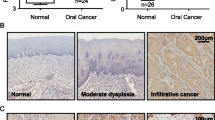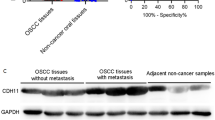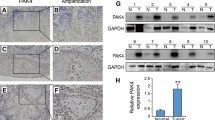Abstract
N-a-Acetyltransferase 10 protein (Naa10p) is a potential prognostic biomarker and a modulator of several types of cancer. Despite the efforts to elucidate the relationship between Naa10p expression and clinical prognosis, little is known about its expression and role in human oral squamous cell carcinoma (OSCC). In this study, we firstly detected the mRNA and protein levels of Naa10p in 10 paired OSCC tissue samples and found Naa10p was frequently overexpressed in the tumor tissues of patients with OSCC. Further detection by immunohistochemistry was used to examine Naa10p expression in 124 OSCC tumor specimens by tissue microarray (TMA), and a relative high level of Naa10p protein expression was found in 98 out of 124 cases (79.03 %). Additional analyses illustrated that Naa10p expression inversely correlated with clinical stage (p = 0.047), degree of lymph node status (p = 0.020), differentiation (p = 0.022), and recurrence (p = 0.016) of patients with OSCC. The survival analysis showed that patients with Naa10p-positive expression had a better prognosis for disease-free survival (DFS) or overall survival (OS) than those with Naa10p-negative expression (p = 0.003 for both). Furthermore, we assessed the effect of Naa10p knockdown on motility of oral cancer cells in vitro, and the results showed that Naa10p inhibit cell wound healing, migration, and invasion. In summary, our study illustrated that the expression of Naa10p had a potential value for predicting the progression of OSCC and prognosis of OSCC patients.




Similar content being viewed by others
References
Parkin DM, Bray F, Ferlay J, Pisani P. Estimating the world cancer burden: Globocan 2000. Int J Cancer. 2001;94:153–6.
Johnson NW, Warnakulasuriya S, Gupta PC, Dimba E, Chindia M, Otoh EC, et al. Global oral health inequalities in incidence and outcomes for oral cancer: causes and solutions. Adv Dent Res. 2011;23:237–46.
Bodner L, Manor E, Friger MD, van der Waal I. Oral squamous cell carcinoma in patients twenty years of age or younger-review and analysis of 186 reported cases. Oral Oncol. 2014;50:84–9.
Clayman GL, Ebihara S, Terada M, Mukai K, Goepfert H. Report of the tenth international symposium of the foundation for promotion of cancer research: basic and clinical research in head and neck cancer. Jpn J Clin Oncol. 1997;27:361–8.
Argiris A, Karamouzis MV, Raben D, Ferris RL. Head and neck cancer. Lancet. 2008;371:1695–709.
Smith RA, Cokkinides V, Eyre HJ. American cancer society guidelines for the early detection of cancer. CA Cancer J Clin. 2006;56(11–25):49–50.
Lim JH, Park JW, Chun YS. Human arrest defective 1 acetylates and activates beta-catenin, promoting lung cancer cell proliferation. Cancer Res. 2006;66:10677–82.
Seo JH, Cha JH, Park JH, Jeong CH, Park ZY, Lee HS, et al. Arrest defective 1 autoacetylation is a critical sep in its ability to stimulate cancer cell proliferation. Cancer Res. 2010;70:4422–32.
Xu H, Jiang B, Meng L, Ren T, Zeng Y, Wu J, et al. N-α-Acetyltransferase 10 protein inhibits apoptosis through RelA/p65-regulated MCL1 expression. Carcinogenesis. 2012;33:1193–202.
Arnesen T, Gromyko D, Pendino F, Ryningen A, Varhaug JE, Lillehaug JR. Induction of apoptosis in human cells by RNAi-mediated knockdown of hARD1 and NATH, components of the protein N-α-acetyltransferase complex. Oncogene. 2006;25:4350–60.
Hua KT, Tan CT, Johansson G, Lee JM, Yang PW, Lu HY, et al. N-α-Acetyltransferase 10 protein suppresses cancer cell metastasis by binding PIX proteins and inhibiting Cdc42/Rac1 activity. Cancer Cell. 2011;19:218–31.
Zeng Y, Min L, Han Y, Meng L, Liu C, Xie Y, et al. Inhibition of STAT5a by Naa10p contributes to decreased breast cancer metastasis. Carcinogenesis. 2014;35:2244–53.
Kuo HP, Lee DF, Chen CT, Liu M, Chou CK, Lee HJ, et al. ARD1 stabilization of TSC2 suppresses tumorigenesis through the mTOR signaling pathway. Sci Signal. 2010;3:ra9.
Lim JH, Chun YS, Park JW. Hypoxia-inducible factor 1 alpha obstructs a Wnt signaling pathway by inhibiting the hARD1-mediated activation of beta-catenin. Cancer Res. 2008;68:5177–84.
Ohkawa N, Sugisaki S, Tokunaga E, Fujitani K, Hayasaka T, Setou M, et al. N-acetyltransferase ARD1-NAT1 regulates neuronal dendritic development. Genes Cells. 2008;13:1171–83.
Wang Z, Wang Z, Guo J, Li Y, Bavarva JH, Qian C, et al. Inactivation of androgen-induced regulator ARD1 inhibits androgen receptor acetylation and prostate tumorigenesis. Proc Natl Acad Sci U S A. 2012;109:3053–8.
Lee CF, Ou DS, Lee SB, Chang LH, Lin RK, Li YS, et al. hNaa10p contributes to tumorigenesis by facilitating DNMT1-mediated tumor suppressor gene silencing. J Clin Invest. 2010;120:2920–30.
Ren T, Jiang B, Jin G, Li J, Dong B, Zhang J, et al. Generation of novel monoclonal antibodies and their application for detecting ARD1 expression in colorectal cancer. Cancer Lett. 2008;264:83–92.
Jiang B, Ren T, Dong B, Qu L, Jin G, Li J, et al. Peptide mimic isolated by autoantibody reveals human arrest defective 1 overexpression is associated with poor prognosis for colon cancer patients. Am J Pathol. 2010;177:1095–103.
Midorikawa Y, Tsutsumi S, Taniguchi H, Ishii M, Kobune Y, Kodama T, et al. Identification of genes associated with dedifferentiation of hepatocellular carcinoma with expression profiling analysis. Jpn J Cancer Res. 2002;93:636–43.
Huang E, Cheng SH, Dressman H, Pittman J, Tsou MH, Horng CF, et al. Gene expression predictors of breast cancer outcomes. Lancet. 2003;361:1590–6.
Zeng Y, Liu C, Dong B, Li Y, Jiang B, Xu Y, et al. Inverse correlation between Naa10p and MMP-9 expression and the combined prognostic value in breast cancer patients. Med Oncol. 2013;30:562.
Wang ZH, Gong JL, Yu M, Yang H, Lai JH, Ma MX, et al. Up-regulation of human arrest-defective 1 protein is correlated with metastatic phenotype and poor prognosis in breast cancer. Asian Pac J Cancer Prev. 2011;12:1973–7.
Yu M, Gong J, Ma M, Yang H, Lai J, Wu H, et al. Immunohistochemical analysis of human arrest-defective-1 expressed in cancers in vivo. Oncol Rep. 2009;21:909–15.
Arnesen T, Anderson D, Baldersheim C, Lanotte M, Varhaug JE, Lillehaug JR. Identification and characterization of the human ARD1-NATH protein acetyltransferase complex. Biochem J. 2005;386:433–43.
Jeong JW, Bae MK, Ahn MY, Kim SH, Sohn TK, Bae MH, et al. Regulation and destabilization of HIF-1alpha by ARD1-mediated acetylation. Cell. 2002;111:709–20.
Kalvik TV, Arnesen T. Protein N-terminal acetyltransferases in cancer. Oncogene. 2013;32:269–76.
Lee MN, Lee SN, Kim SH, Kim B, Jung BK, Seo JH, et al. Roles of arrest-defective protein 1(225) and hypoxia-inducible factor 1alpha in tumor growth and metastasis. J Natl Cancer Inst. 2010;102:426–42.
Shin DH, Chun YS, Lee KH, Shin HW, Park JW. Arrest defective-1 controls tumor cell behavior by acetylating myosin light chain kinase. PLoS One. 2009;4:e7451.
Starheim KK, Gromyko D, Velde R, Varhaug JE, Arnesen T. Composition and biological significance of the human N alpha-terminal acetyltransferases. BMC Proc. 2009;3 Suppl 6:S3.
Vetting MW, S de Carvalho LP, Yu M, Hegde SS, Magnet S, Roderick SL, et al. Structure and functions of the GNAT superfamily of acetyltransferases. Arch Biochem Biophys. 2005;433:212–26.
Marmorstein R, Zhou MM. Writers and readers of histone acetylation: structure, mechanism, and inhibition. Cold Spring Harb Perspect Biol. 2014;6:a018762.
Kalkhoven E. CBP and p300: HATs for different occasions. Biochem Pharmacol. 2004;68:1145–55.
Bouchal J, Santer FR, Höschele PP, Tomastikova E, Neuwirt H, Culig Z. Transcriptional coactivators p300 and CBP stimulate estrogen receptor-beta signaling and regulate cellular events in prostate cancer. Prostate. 2011;71:431–7.
Aksnes H, Hole K, Arnesen T. Molecular, cellular, and physiological significance of N-terminal acetylation. Int Rev Cell Mol Biol. 2015;316:267–305.
Whiteway M, Freedman R, Van Arsdell S, Szostak JW, Thorner J. The yeast ARD1 gene product is required for repression of cryptic mating-type information at the HML locus. Mol Cell Biol. 1987;7:3713–22.
Ametzazurra A, Larrea E, Civeira MP, Prieto J, Aldabe R. Implication of human N-alpha- acetyltransferase 5 in cellular proliferation and carcinogenesis. Oncogene. 2008;27:7296–306.
Polevoda B, Sherman F. NatC Nalpha-terminal acetyltransferase of yeast contains three subunits, Mak3p, Mak10p, and Mak31p. J Biol Chem. 2001;276:20154–9.
Samanfar B, Omidi K, Hooshyar M, Laliberte B, Alamgir M, Seal AJ, et al. Large-scale investigation of oxygen response mutants in Saccharomyces cerevisiae. Mol Biosyst. 2013;9:1351–9.
Askree SH, Yehuda T, Smolikov S, Gurevich R, Hawk J, Coker C, et al. A genome-wide screen for Saccharomyces cerevisiae deletion mutants that affect telomere length. Proc Natl Acad Sci U S A. 2004;10:8658–63.
Hole K, Van Damme P, Dalva M, Aksnes H, Glomnes N, Varhaug JE, et al. The humanN-alpha-acetyltransferase40 (hNaa40p/hNatD) is conserved from yeast and N-terminally acetylates histones H2A and H4. PLoS One. 2011;6:e24713.
Polevoda B, Hoskins J, Sherman F. Properties of Nat4, an N(alpha)-acetyltransferase of Saccharomyces cerevisiae that modifies N termini of histones H2A and H4. Mol Cell Biol. 2009;29:2913–24.
Evjenth R, Hole K, Karlsen OA, Ziegler M, Arnesen T, Lillehaug JR. Human Naa50p (Nat5/San) displays both protein N alpha- and N epsilon-acetyltransferase activity. J Biol Chem. 2009;284:31122–9.
Myklebust LM, Van Damme P, Støve SI, Dörfel MJ, Abboud A, Kalvik TV, et al. Biochemical and cellular analysis of Ogden syndrome reveals downstream Nt-acetylation defects. Hum Mol Genet. 2015;24:1956–76.
Takahashi YH, Schulze JM, Jackson J, Hentrich T, Seidel C, Jaspersen SL, et al. Dot1 and histone H3K79 methylation in natural telomeric and HM silencing. Mol Cell. 2011;42:118–26.
Aparicio OM, Billington BL, Gottschling DE. Modifiers of position effect are shared between telomeric and silent mating-type loci in S. cere6isiae. Cell. 1991;66:1279–87.
Acknowledgments
This study was supported by a research grant from the National Natural Science Foundation of China (81560473; 81560442; 31160183; 30960093), Doctoral Foundation and Technology Research and Achievements Transformation Program of Xinjiang production and Construction Corps (2014BB021; 2015 AD003), and High Level Talents Special Foundation of Shihezi University, China (RCZX201330). We deeply appreciate Dr. Chengchao Shou (Peking University Cancer Institute) for generously sharing of anti-Naa10p monoclonal antibody.
Author information
Authors and Affiliations
Corresponding author
Ethics declarations
Conflicts of interest
None
Additional information
Yan Zeng and Jun Zheng are considered joint first authors.
Yan Zeng and Jun Zheng contributed equally to this work.
Rights and permissions
About this article
Cite this article
Zeng, Y., Zheng, J., Zhao, J. et al. High expression of Naa10p associates with lymph node metastasis and predicts favorable prognosis of oral squamous cell carcinoma. Tumor Biol. 37, 6719–6728 (2016). https://doi.org/10.1007/s13277-015-4563-z
Received:
Accepted:
Published:
Issue Date:
DOI: https://doi.org/10.1007/s13277-015-4563-z




